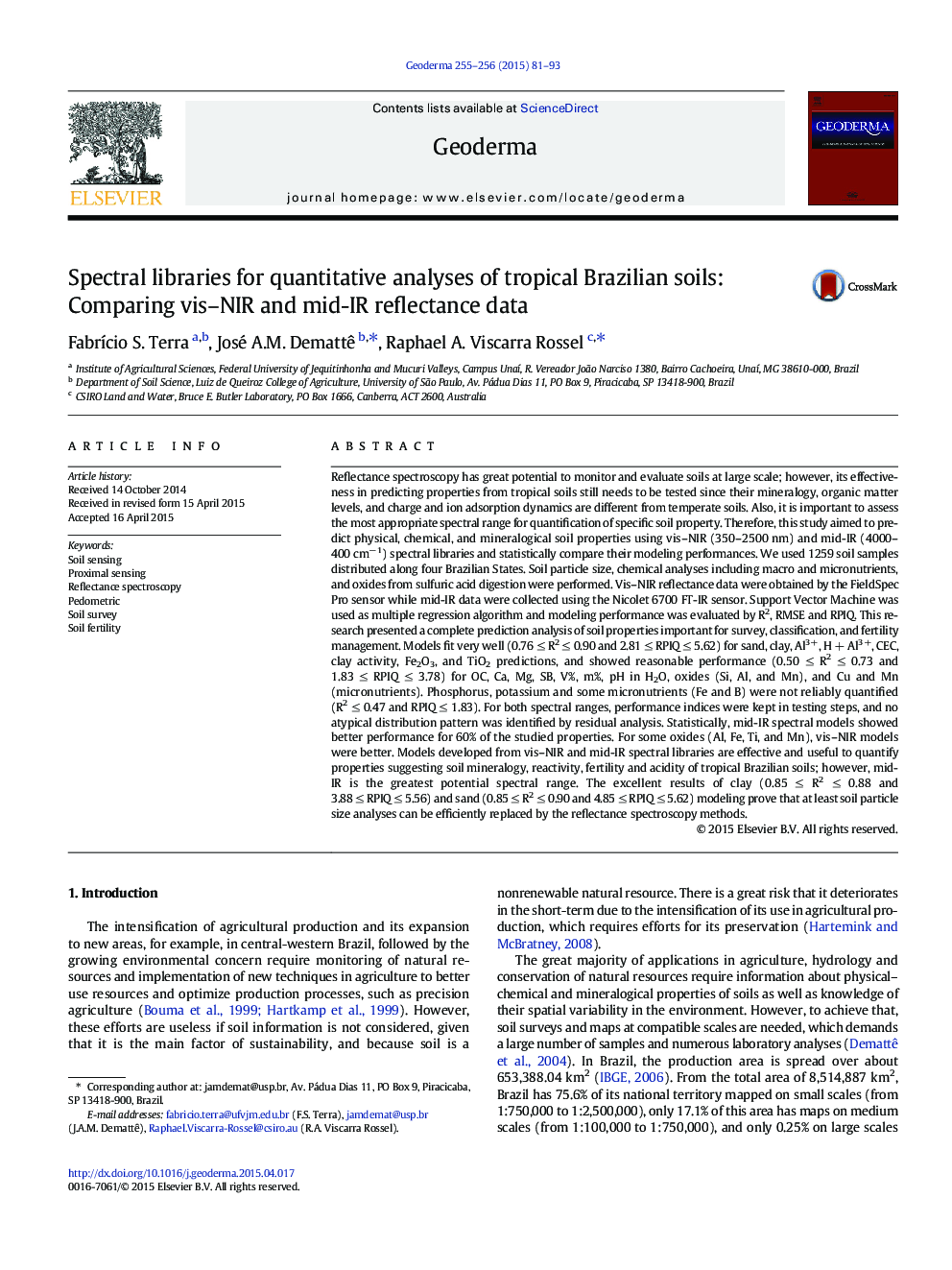| کد مقاله | کد نشریه | سال انتشار | مقاله انگلیسی | نسخه تمام متن |
|---|---|---|---|---|
| 4573148 | 1629458 | 2015 | 13 صفحه PDF | دانلود رایگان |

• Vis–NIR and mid-IR spectroscopy are effective in analyses of tropical Brazilian soils.
• Mid-IR data are better than vis–NIR data to model reactivity and acidity of soils.
• Properties for soil survey and fertility management are better modeled by mid-IR.
• Al, Fe, Ti, and Mn oxides from soil mineralogy are better predicted by vis–NIR data.
• Soil particle size analyses can be efficiently replaced by reflectance spectroscopy.
Reflectance spectroscopy has great potential to monitor and evaluate soils at large scale; however, its effectiveness in predicting properties from tropical soils still needs to be tested since their mineralogy, organic matter levels, and charge and ion adsorption dynamics are different from temperate soils. Also, it is important to assess the most appropriate spectral range for quantification of specific soil property. Therefore, this study aimed to predict physical, chemical, and mineralogical soil properties using vis–NIR (350–2500 nm) and mid-IR (4000–400 cm− 1) spectral libraries and statistically compare their modeling performances. We used 1259 soil samples distributed along four Brazilian States. Soil particle size, chemical analyses including macro and micronutrients, and oxides from sulfuric acid digestion were performed. Vis–NIR reflectance data were obtained by the FieldSpec Pro sensor while mid-IR data were collected using the Nicolet 6700 FT-IR sensor. Support Vector Machine was used as multiple regression algorithm and modeling performance was evaluated by R2, RMSE and RPIQ. This research presented a complete prediction analysis of soil properties important for survey, classification, and fertility management. Models fit very well (0.76 ≤ R2 ≤ 0.90 and 2.81 ≤ RPIQ ≤ 5.62) for sand, clay, Al3+, H + Al3+, CEC, clay activity, Fe2O3, and TiO2 predictions, and showed reasonable performance (0.50 ≤ R2 ≤ 0.73 and 1.83 ≤ RPIQ ≤ 3.78) for OC, Ca, Mg, SB, V%, m%, pH in H2O, oxides (Si, Al, and Mn), and Cu and Mn (micronutrients). Phosphorus, potassium and some micronutrients (Fe and B) were not reliably quantified (R2 ≤ 0.47 and RPIQ ≤ 1.83). For both spectral ranges, performance indices were kept in testing steps, and no atypical distribution pattern was identified by residual analysis. Statistically, mid-IR spectral models showed better performance for 60% of the studied properties. For some oxides (Al, Fe, Ti, and Mn), vis–NIR models were better. Models developed from vis–NIR and mid-IR spectral libraries are effective and useful to quantify properties suggesting soil mineralogy, reactivity, fertility and acidity of tropical Brazilian soils; however, mid-IR is the greatest potential spectral range. The excellent results of clay (0.85 ≤ R2 ≤ 0.88 and 3.88 ≤ RPIQ ≤ 5.56) and sand (0.85 ≤ R2 ≤ 0.90 and 4.85 ≤ RPIQ ≤ 5.62) modeling prove that at least soil particle size analyses can be efficiently replaced by the reflectance spectroscopy methods.
Journal: Geoderma - Volumes 255–256, October 2015, Pages 81–93